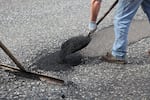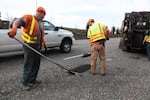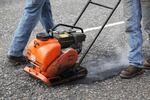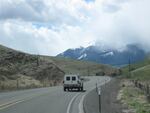REPRESENTED
"Think Out Loud" is traveling to cities and towns across the state to hear about the policy issues that matter to Oregonians. How do the decisions of lawmakers in Salem affect our lives? See our full coverage here.
All around Oregon, drivers, cyclists and pedestrians are struggling with the potholes left behind from a particularly brutal winter. "Think Out Loud" sets out to learn how these ubiquitous hazards fit into the larger plans lawmakers are making to fund maintenance and new construction on Oregon's roads.
Pothole Repair

An ODOT maintenance crew fills potholes on Highway 26.
Julie Sabatier / OPB
This past winter was particularly hard on Oregon's roads: unusually heavy snow storms that led to tire chains requirements, plus more freezing and thawing than usual. You've probably noticed that, as a result, the roads are full of potholes.
Scot Pears has definitely noticed. Pears is a transportation maintenance manager for the Oregon Department of Transportation (ODOT). He and his crew are responsible for Route 217, Route 99 and a large swath of Highway 26 from the Vista Ridge Tunnel up to North Plains. He explained that normally at this time of year, his crew would be focused on mowing the grass on the side of the road and killing off weeds to prepare for springtime.
"None of that work has been done. It's all been focused on potholes," he said.

Scot Pears is a maintenance manager for the Oregon Department of Transportation. He and his crew are responsible for Route 217, Route 99, and a large swath of Highway 26 from the Vista Ridge Tunnel up to North Plains.
Julie Sabatier / OPB
There are two ways to fix a pothole — the hot patch and the cold patch. A cold patch is considered a quick fix. It basically consists of pouring asphalt from a bag into the pothole. These patches are not expected to last long.
"If it's wet and you're putting it in there just to stop cars from breaking their wheels on it, it could last a couple of hours," said Pears.
If the pavement is dry, the more permanent hot patch can be applied. The crews use hot asphalt and a bonding agent that helps the patch stick to the road. It should last until the road is eventually repaved.

An ODOT maintenance crew fills potholes on Highway 26.
Julie Sabatier / OPB
Whether it's an emergency patch or scheduled pothole repair, ODOT often sends a crew of half a dozen workers and three to five vehicles to get the job done. That's because working on a busy highway as traffic whizzes by on either side is dangerous work.
"I've had three members of my crew hit by cars in the last two years," Pears said. "Two of them involved hospital stays. One individual ... actually got hit by a car, flew over on the hood, smashed the front windshield and then got tossed up under the gate of the truck that he was standing behind. ... We were lucky we didn't lose a member of our crew."

An ODOT maintenance crew uses a machine that tamps down asphalt after filling a pothole on Highway 26.
Julie Sabatier / OPB
The Big Picture
Of course, patching potholes are far from the only thing ODOT has to spend money on. So how does the agency decide what to prioritize? According to ODOT assistant director Travis Brouwer, basic maintenance and preservation are a top priority.
"Oregonians have invested billions of dollars in the transportation system over generations and we need to keep that system in good working order," he said. "Generally, we prioritize the basic fixing the system above the expansion of that system."

Mount Hood from Highway 26 near Government Camp, Oregon, on March 16, 2017.
Bradley W. Parks / OPB
Basic maintenance includes clearing dead animals off the road, plowing snow and repaving in addition to repairing potholes. But it doesn't include expanding public transit, widening highways or adding infrastructure for cyclists and pedestrians. All of that falls under new construction, which is also a big part of ODOT's purview.
"We look at the entire multimodal transportation system and try to figure out where we can have the biggest bang for the buck through some strategic investment in additional capacity," Brouwer explained.

OPB
The Oregon Transportation Commission ultimately decides how to allocate the money in ODOT's budget. The commission is made up of local government officials and regional business leaders. But before that group can decide how to spend ODOT's budget, the legislature has to decide how much the agency will get.
The Bigger Picture
In addition to making up a $1.6 billion budget shortfall, lawmakers are under pressure to find a way to fund transportation upgrades and the basic maintenance Brouwer described as a top priority.
"We know that whatever we do, it won't be enough," said Rep. Cliff Bentz.
Bentz, a Republican from Ontario in eastern Oregon, is the co-vice chair of the joint committee on transportation preservation and modernization. That's the committee charged with the daunting task of coming up with a transportation package for the entire legislature to vote on before the end of the session.
Lawmakers estimate that it would take a 30 cents a gallon increase or a doubling of the state gas tax to bring in enough funding for everything ODOT wants to accomplish in terms of maintenance and new construction.
Sen. Lee Beyer, a Democratic from Springfield and the co-chair of the joint committee, said the committee is considering a gradual increase over 20 years because voters would be unlikely to accept a 30 cents a gallon increase if it came all at once. Also, because there's not enough construction capability in the state to do all the necessary maintenance at once.
One thing lawmakers agree needs to be addressed is congestion on Oregon's urban roads, particularly in Portland. Beyer said this is a concern to people around the state, even if they never drive on Portland's highways.
"One of the things people don't think about is that we're an exporting state and when we traveled around the state, the thing that we heard the most from the business community is, 'You've got to fix the congestion in Portland because everything we make and sell goes through there,'" he explained.
Bentz said the plan the committee is considering will probably go over well with his constituents in eastern Oregon because the proposal will likely ask more of urban Oregonians than those who live in rural areas.
Bentz and Beyer say their committee expects to introduce a transportation proposal sometime in May.

OPB
In the meantime, when Oregonians get frustrated by potholes, they can report them using the "Ask ODOT" system the agency has set up for citizens to help them spot problems on state roads. Pears said when he gets a report of something that's in the area he's responsible for, he or another member of his crew will check it out.
"And you could expect an answer back from "Ask ODOT" within five days addressing what will be done with your problem or giving you an explanation as to why something did or didn't happen," he said.
